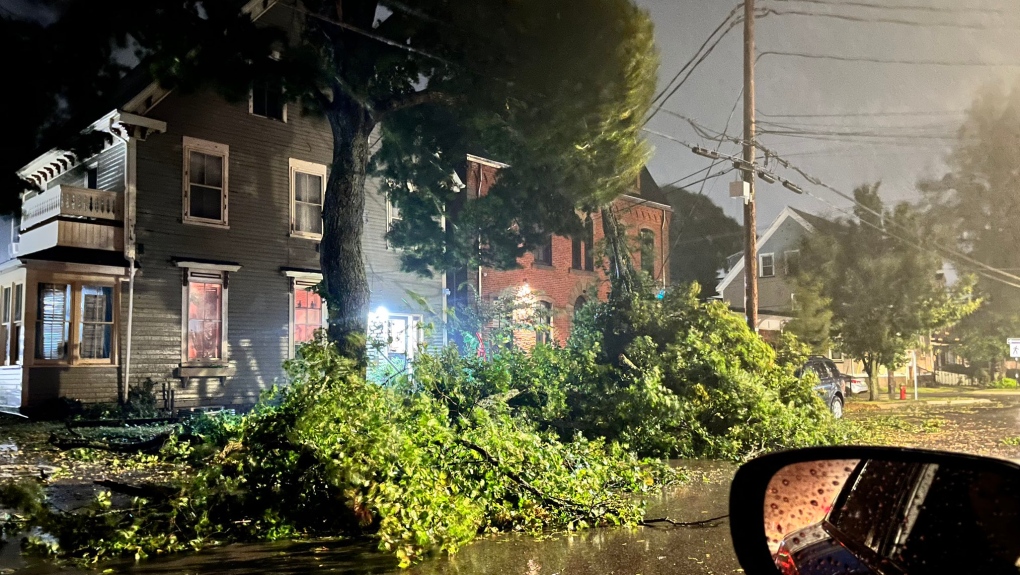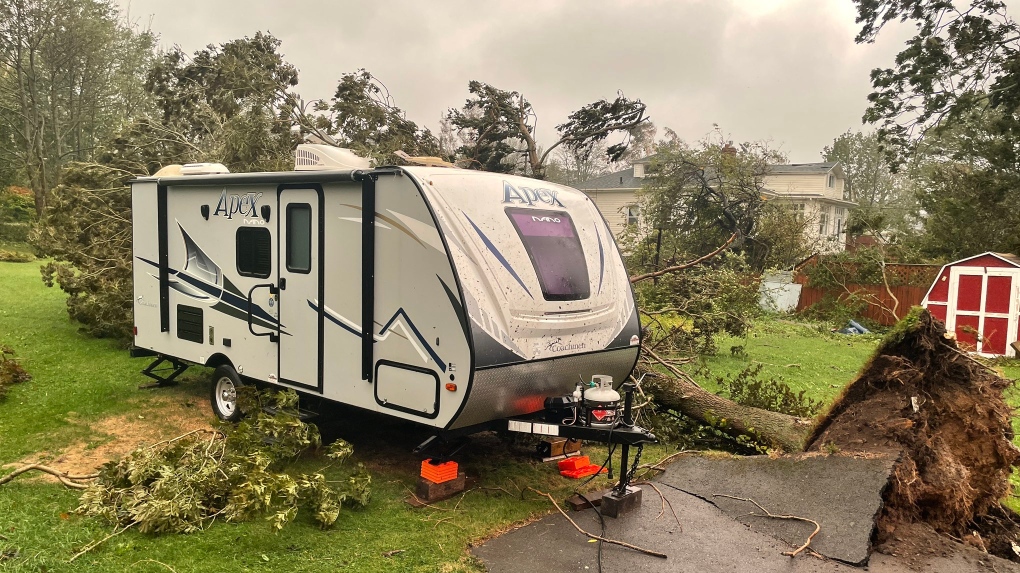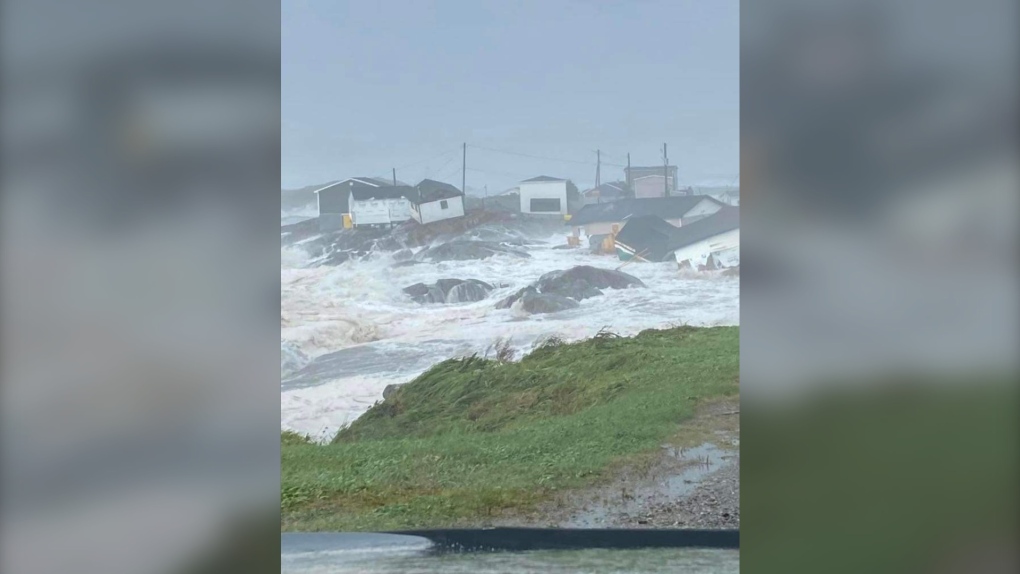Powerful post-tropical storm Fiona makes landfall near Canso, N.S.
Fiona brought powerful and destructive winds to parts of the Maritimes Saturday resulting in hundreds of thousands of people losing power.
The storm landed east of Nova Scotia shortly after 4 a.m. Saturday between Canso and Guysborough.
The Canadian Hurricane Centre in Dartmouth, N.S., said Fiona set an unofficial record for the lowest-ever barometric pressure for a tropical storm making landfall in Canada. The recorded pressure at Hart Island was 931.6 millibars.
Thousands of residents across the Maritimes lost power due to Fiona's strong forces. A detailed article on power outages throughout the Maritimes can be found here.
WIND TOTALS
Fiona was the equivalent of a Category 1 hurricane when it made landfall, with maximum winds around 150 km/h.
Sustained winds between 60 and 80 km/h were reported early Saturday morning for large areas of Nova Scotia. Extremely high winds were reported in areas of Cape Breton, including Grand Etang with gusts topping 167 km/h.
The Halifax Stanfield International Airport reported a gust of 109 km/h at 3 a.m., and a gust hit 135 km/h at the mouth of Halifax Harbour.
In Sydney, gusts hit 141 km/h at 3 a.m. local time, causing severe damage to some homes.
At the Charlottetown airport, the wind was gusting at 120 km/h at 10 a.m. local time, and a 150 km/h gust was recorded at the eastern edge of theisland at East Point.
DAMAGE AND RESTORATIONS
Nova Scotia Premier Tim Houston was in Pictou County during the storm. He said the damage in that area is severe.
"Trees down, lots of property damage for sure, some superficial but some very, very significant," Houston said.
Houston said support from Ottawa has been requested.
"We've been in contact with our federal partners, and we have requested military and disaster assistance. So, I have to send a huge thank you to our friends in Ontario who have been instrumental in sending support," said Houston. "An official request for aid has been made and we have more support and more workers on the way."
"But this was a dangerous situation overnight, just from what I'm hearing from people and what I experienced here in my home. This was quite a historic storm and it's definitely not over yet."
RCMP members across Nova Scotia responded to “numerous” calls overnight and into Saturday morning. Police say some were routine calls, but the majority have been due to issues with roads, including washouts, downed trees, power lines and debris.
Although the storm is leaving the region, Nova Scotia RCMP Cpl. Chris Marshall says people should still avoid driving.
“If you don’t need to be on the road, we would ask that you please stay off the road,” he says. “Trying to get into a recovery, or a cleanup, phase there’s still going to be high winds, there’s going to be risks to yourself to being out on the roads. So, until the storm is completely cleared, until first responders and emergency crews can get out to clean out those roads, we just ask that you please stay home.”
The City of Charlottetown is also urging people to stay inside unless “absolutely necessary.” The city says crews are working to finalize reception centres for people who cannot stay indoors. They’re also urging people to not go to the centres until it is safe to do so.
 A downed tree caused by post-tropical storm Fiona is pictured in Charlottetown. (Source: Twitter/ChtownPolice)
A downed tree caused by post-tropical storm Fiona is pictured in Charlottetown. (Source: Twitter/ChtownPolice)
Charlottetown Police Chief Brad MacConnell says his members are prioritizing their calls to emergency situations Saturday morning into the afternoon.
"Getting people shelter that their homes have been compromised or their apartment buildings have been compromised by falling trees," said MacConnell.
Images from downtown Charlottetown show extensive damage. MacConnell says that devastation is being seen all around the island.
"But certainly, in Charlottetown, we've been hit hard here. I don't think there's a street that doesn't have a fallen tree or downed power line, so we certainly are asking people to stay home. It's not safe to be out and our first responders are very overtasked right now dealing with emergency situations."
 A resident in the Cape Breton community of Westmount says this 60-foot tree missed his trailer by mere inches. (Source: Twitter/Tom Mills)
A resident in the Cape Breton community of Westmount says this 60-foot tree missed his trailer by mere inches. (Source: Twitter/Tom Mills)
In a statement late Saturday afternoon, New Brunswick Premier Blaine Higgs says his province was lucky to be spared from Fiona, unlike its neighbouring provinces of Nova Scotia, P.E.I. and Newfoundland and Labrador.
The premier says crews are still out assessing the damages of the storm.
"The extent of the damage may not be known for several days and we will be looking to determine what kind of financial assistance may be required," Higgs said.
RAINFALL TOTALS
Parts of eastern Nova Scotia and Prince Edward Island have recorded 75 to 150 millimetres of rainfall. Final totals have yet to be tallied.
Heavy rains also wrapped back towards to eastern coastline of New Brunswick, as well as northern and southwestern areas of Nova Scotia.
WARNINGS AND RISKS
In an update on CTV News Saturday morning, CTV Atlantic Chief Meteorologist Kalin Mitchell says a risk of storm surgeremains in the eastern part of the Maritimes and into the southwest of Newfoundland.
"A particular concern is the fact that we had some high tide times this morning," he said. "Now, because we're going to be getting passed those high tide times and the wind direction starts to change... that risk of storm surge is going to subside later into today, at least for the eastern half of the Maritimes."
Storm Surge Warnings remain in effect for most of the Gulf of St. Lawrence, southwestern Newfoundland, eastern Nova Scotia and the East Coast of New Brunswick, with waves possibly surpassing 12 metres in eastern portions of the Gulf of St. Lawrence and Cabot Strait.
Mitchell says Fiona's maximum sustained winds were 140 km/h, as of 9 a.m.
"It has slowed its movement towards the north, but it is still moving towards the north," Mitchell said. "And that's going to take it up into the Gulf of St. Lawrence."
Coastal flooding remains a threat for parts of Nova Scotia, Prince Edward Island including the Northumberland Strait, the Gulf of St. Lawrence region including Iles-de-la-Madeleine and eastern New Brunswick, southwest Newfoundland, the St. Lawrence Estuary and the Quebec Lower North Shore.
 Severe flooding from Fiona is pictured in Burnt Islands, a small coastal community on the southwest coast of Newfoundland. (Courtesy: Scott Burry)
Severe flooding from Fiona is pictured in Burnt Islands, a small coastal community on the southwest coast of Newfoundland. (Courtesy: Scott Burry)
Hurricane and tropical storm warnings remain in effect for most areas.
The most up-to-date weather warnings and watches can be found on Environment Canada's website.
With files from The Canadian Press.
CTVNews.ca Top Stories

Ministers Joly, LeBlanc travel to Florida to meet with Trump's team
Two members of Prime Minister Justin Trudeau's cabinet will be in Palm Beach, Fla., Friday to meet with members of Donald Trump's team.
Hwy. 401 off-ramp shut down due to Boxing Day deal-hunters now reopen
A Highway 401 off-ramp west of Toronto that became so clogged up with Boxing Day deal-hunters Thursday that police had to shut it down out of safety concerns has re-opened.
India alleges widespread trafficking of international students through Canada to U.S.
Indian law enforcement agencies say they are investigating alleged links between dozens of colleges in Canada and two 'entities' in Mumbai accused of illegally ferrying students across the Canada-United States border.
Teen actor Hudson Meek, who appeared in 'Baby Driver,' dies after falling from moving vehicle
Hudson Meek, the 16-year-old actor who appeared in 'Baby Driver,' died last week after falling from a moving vehicle in Vestavia Hills, Alabama, according to CNN affiliate WVTM.
B.C woman awarded nearly $750K in court case against contractor
A B.C. woman has been awarded nearly $750,000 in damages in a dispute with a contractor who strung her along for a year and a half and failed to complete a renovation, according to a recent court decision.
Florida pizza deliverer charged with stabbing pregnant woman after tip dispute
A pizza deliverer in central Florida has been charged with pushing her way into a motel room with an accomplice and stabbing a pregnant woman after a dispute over a tip, authorities said.
2 minors, 2 adults critically injured in south Calgary crash; incident was preceded by a robbery
Multiple people were rushed to hospital, including two minors, in the aftermath of a serious vehicle collision on Thursday morning.
Christmas Eve stowaway caught on Delta airplane at Seattle airport
A stowaway was caught trying to nab a ride on a Delta Air Lines plane at Seattle-Tacoma International Airport on Christmas Eve.
Aviation experts say Russia's air defence fire likely caused Azerbaijan plane crash as nation mourns
Aviation experts said Thursday that Russian air defence fire was likely responsible for the Azerbaijani plane crash the day before that killed 38 people and left all 29 survivors injured.
































